Quick Success Data ScienceThey can in college footballPhoto by Dave Adamson on UnsplashI have an obnoxious friend who likes to brag about his alma mater’s gridiron team every chance he gets. Over the last few years, his team won more regular-season games...
Quick Success Data Science
They can in college football
 Photo by Dave Adamson on Unsplash
Photo by Dave Adamson on UnsplashI have an obnoxious friend who likes to brag about his alma mater’s gridiron team every chance he gets. Over the last few years, his team won more regular-season games (by one game) than ever before. Now he’s crowing about it, comparing (way) back to his school’s glory years. There’s just one problem; back in the 1950s and 60s, teams played only 10 regular season games.
In the 1970s, this increased to 11.
In 2006, it increased to 12.
Winning 9 out of 10 games in 1960 yielded a winning percentage of 90%. Winning 10 out of 12 today yields only 83%. So, winning 10 games is not as great as it sounds.
But there’s more to it than this. What if the extra games are, on average, easier wins? That makes breaking old records even less impressive.
The nice thing about data science is that you don’t have to argue over things you can prove. A good data scientist should be able to think analytically and marshal data to their cause.
In this article, we’ll evaluate the significance of playing more games on winning more games. This will involve universal data science practices, such as formulating a premise, designing the analysis, selecting appropriate data, and presenting the results.
Specifically, we’ll evaluate the impact of changing from 11 regular season games to 12 games. To smooth out the effects of coaching changes and constantly evolving rules and regulations, we’ll use my friend’s alma mater and five other schools with similar football traditions, throughout 34 seasons straddling 2006.
A Thought Experiment
Before we start, let’s do a thought experiment. If a college football powerhouse school (such as Alabama, Ohio State, or Oklahoma) adds a random team to their schedule, they will probably win this extra game, as they are stronger than most other teams.
Likewise, bottom-rung teams with little football tradition would be expected to lose this extra game, as most other teams are better than they are.
Theoretically, teams in the middle would?—?assuming they drew randomly from the full roster of teams?—?win this extra game about half the time. This would result in an average improvement to their record of 0.5 games per season, all things being equal. Thus, there will be years when they have the opportunity of winning at least one game more than they have historically.
Designing the Approach
As Ronald Reagan liked to say, “Trust but verify.” For middle-tier teams, does real life conform to this theory? Do they win, on average, an additional 0.5 games per year?
To check, I looked at six teams that regularly finish in the lower half of the powerful Southeastern Conference (SEC):
Ole MissMissouriSouth CarolinaKentuckyMississippi StateVanderbilt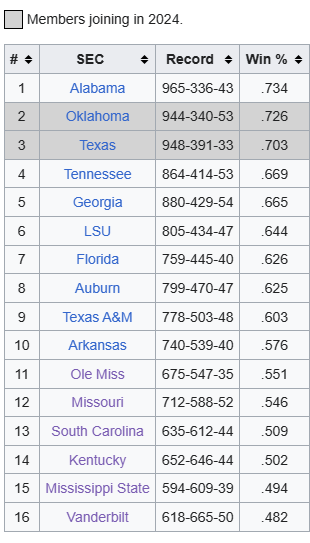 SEC teams ranked by historical win percentage (Wikipedia)
SEC teams ranked by historical win percentage (Wikipedia)The Congrove computer rankings for these teams placed them in the middle-to-lower range of FBS teams for 2005, the year before the start of the 12-game regular season.
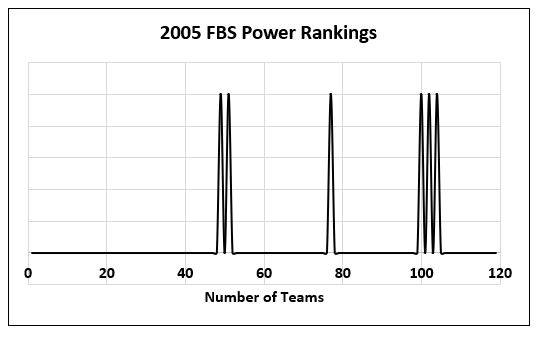 The 2005 ranking of the six teams against all teams (by the author and collegefootballpoll.com)NOTE: The Football Bowl Subdivision, formerly Division I-A, is the highest level of college football in the United States. The FBS includes the largest National Collegiate Athletic Association (NCAA) schools. As of 2023, there are 133 teams in the FBS.
The 2005 ranking of the six teams against all teams (by the author and collegefootballpoll.com)NOTE: The Football Bowl Subdivision, formerly Division I-A, is the highest level of college football in the United States. The FBS includes the largest National Collegiate Athletic Association (NCAA) schools. As of 2023, there are 133 teams in the FBS.The analysis covers the years 1989–2023 but omits the pandemic-shortened 2020 season. This allows for 17 seasons before and 17 seasons after the start of the 12-game season in 2006.
The win-loss records were sourced from Wikipedia. Forfeited wins were counted as wins.
Mississippi State, Ole Miss, Kentucky, and Vanderbilt played seven conference games per season until 1992 when they began playing eight.
South Carolina joined the SEC in 1992 and started playing eight conference games yearly. Before that, they played a mixture of games against mainly conference teams (SEC, ACC, Big East) and some strong independents, including Florida State and West Virginia.
Missouri joined the SEC in 2012 and began playing eight conference games yearly. Before that, they played in the comparable Big 12 conference where they played seven conference games per year before the 1996 season and then eight after that.
The Results
The results of the analysis are shown below as a scatterplot with linear trend lines. All of the trend lines have a positive slope, with Missouri improving the most and Ole Miss improving the least.
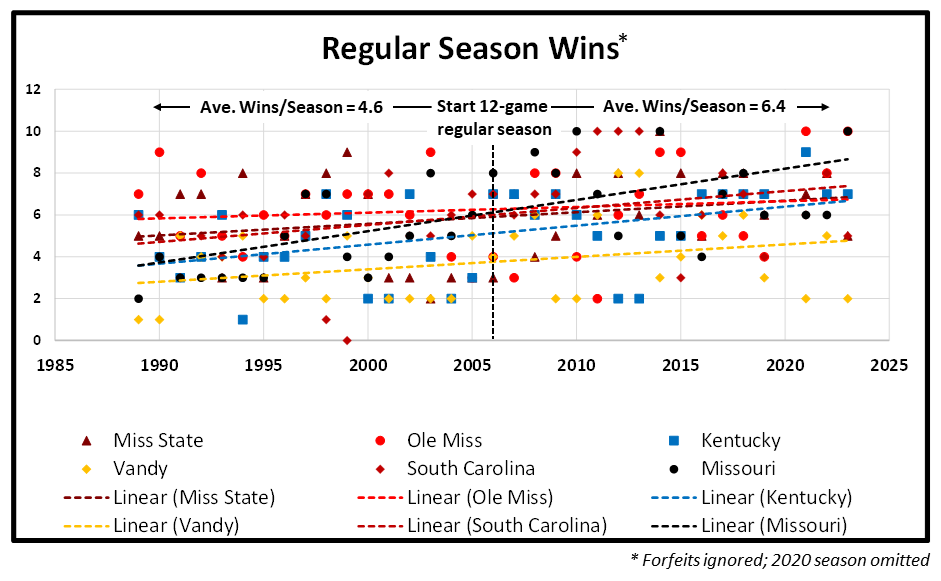 Scatterplot of regular season wins per team from 1989–2023 (by the author)
Scatterplot of regular season wins per team from 1989–2023 (by the author)In the 17 years before the start of the 12-game regular season, these six teams won, on average, 4.63 games. In the subsequent 17 years, they won, on average, 6.37 games. Thus, on average, they’ve won 1.74 more games playing 12 games a season.
Here’s another view using a stacked area chart. The “thicker” the colored area, the higher the number of wins. There’s a notable change in “plateau height” after 2006.
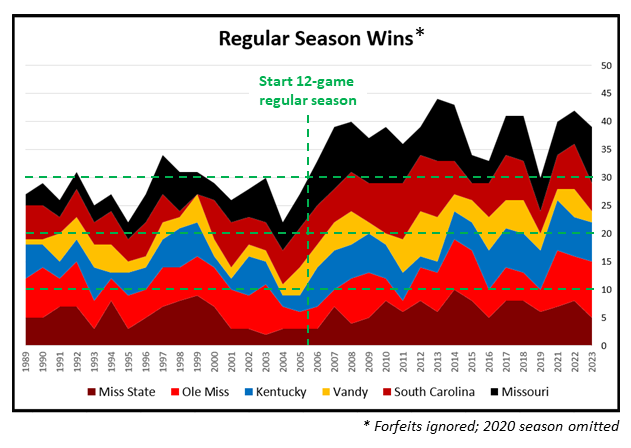 Stacked area chart for the six teams analyzed (by the author)
Stacked area chart for the six teams analyzed (by the author)Implications
For all the teams in the analysis, the additional game was a non-conference match. This means the schools had more control over scheduling.
Had they chosen opponents of equal strength, we would’ve expected parity going forward resulting in an improvement of 0.5 games per season, as each team would win about half the time. The fact that they win an additional 1.74 games per season, on average, suggests that they are using this extra game to pad their schedule with an inferior opponent.
This is evident in the 2022 season, as shown in the figure below. While there are a few tough non-conference opponents (South Carolina has a traditional rivalry with Clemson, for example), the average ranking of the six SEC teams was almost twice that of their opponents. Some of these opponents were even from the lower-level Football Championship Subdivision (FCS).
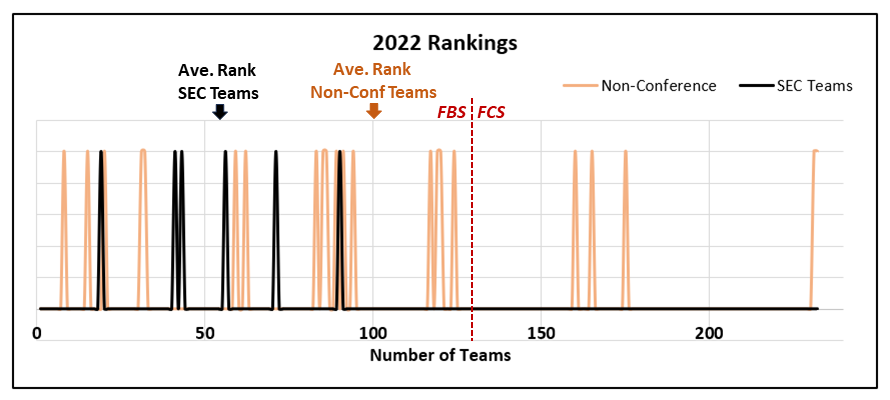 Rankings of the 6 SEC teams vs. their non-conference opponents in 2022 (by the author using collegefootballpoll.com)NOTE: to combine the FBS and FCS rankings in the previous diagram, I added the FCS ranking to the total number of teams in the FBS in 2022 (131). Thus, an FCS ranking of 5 becomes 136 (5 + 131).
Rankings of the 6 SEC teams vs. their non-conference opponents in 2022 (by the author using collegefootballpoll.com)NOTE: to combine the FBS and FCS rankings in the previous diagram, I added the FCS ranking to the total number of teams in the FBS in 2022 (131). Thus, an FCS ranking of 5 becomes 136 (5 + 131).Of course, achieving an average improvement of 1.7 games per regular season required more than adding a single easy game to the schedule. These six teams have worked hard to improve their programs in the last two decades, and it shows, based on computer rankings by collegefootballpoll.com.
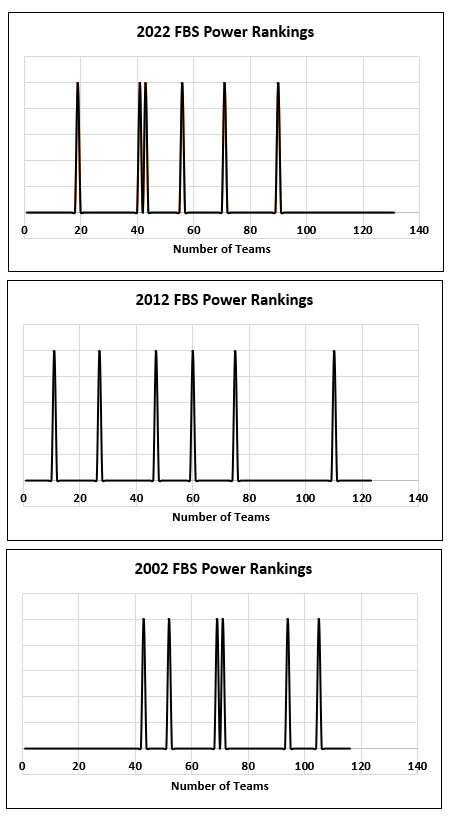 End-of-season rankings for the six teams for 2002, 2012, and 2022 (by the author and collegefootballpoll.com)
End-of-season rankings for the six teams for 2002, 2012, and 2022 (by the author and collegefootballpoll.com)Do the generally higher rankings have anything to do with playing that extra winnable game every year since 2006? Perhaps. But the fact that they win, on average, almost two more games per season suggests additional factors are at play, such as improvements in facilities, coaching, recruiting, and so on.
Conclusion
This was a small project, but it highlighted the ability of data science to bring together logical thinking, hard data, and structured analysis to address an argument.
At the end of the day, just because your mid-tier college football team has the occasional 9 or 10-win season now when they never achieved more than 7 or 8-win seasons in the past may not be that impressive. Teams today play more games than in the past, and at least one of them is probably a weaker opponent by design.
Thanks!
Thanks for reading and follow me for more Quick Success Data Science projects in the future.
Do More Games Mean More Wins? was originally published in Towards Data Science on Medium, where people are continuing the conversation by highlighting and responding to this story.


